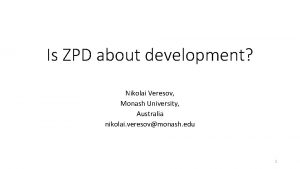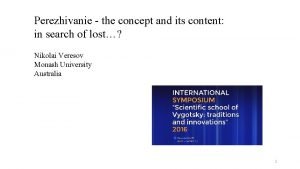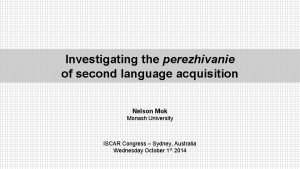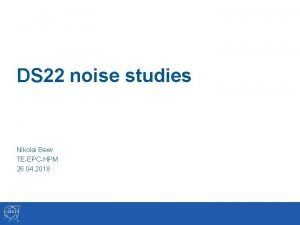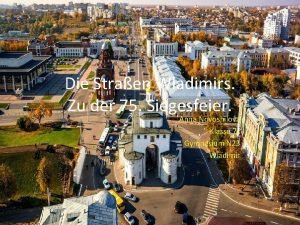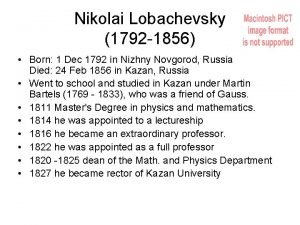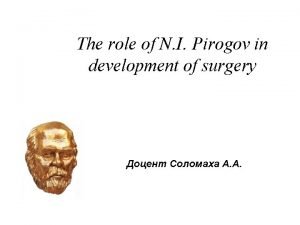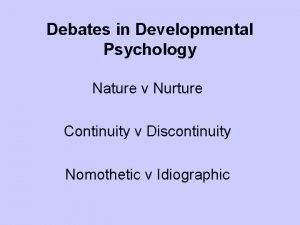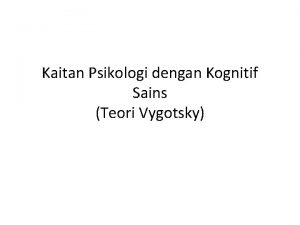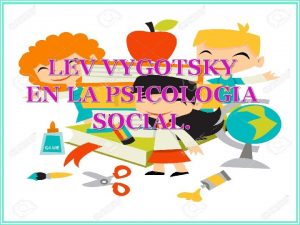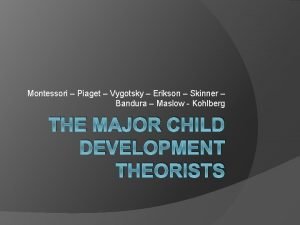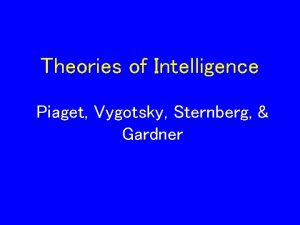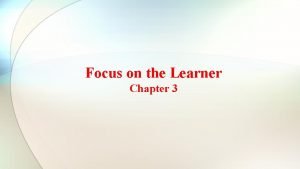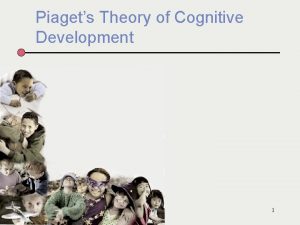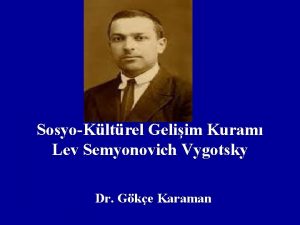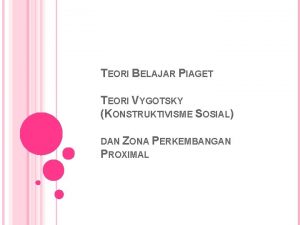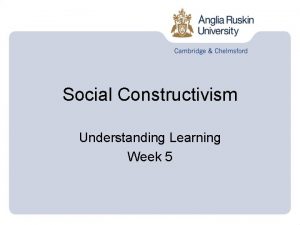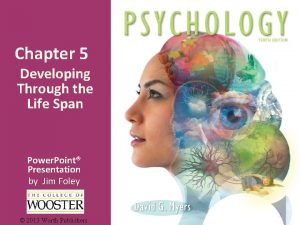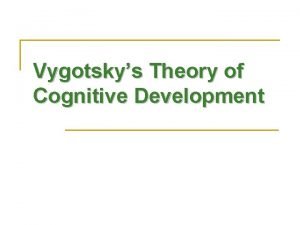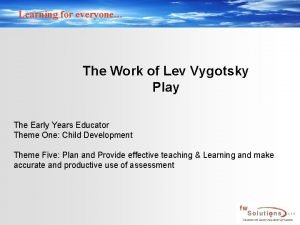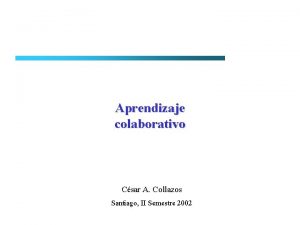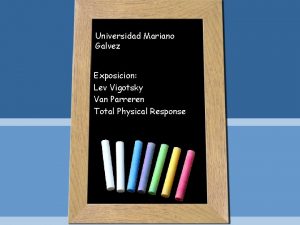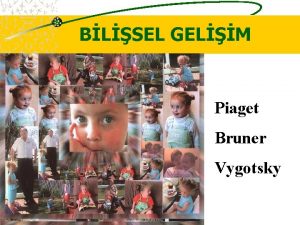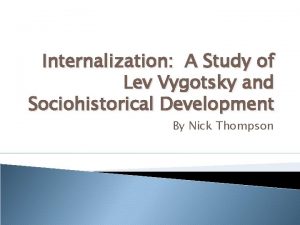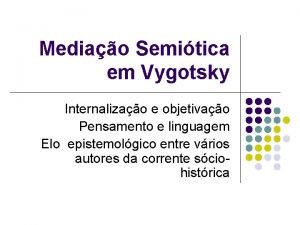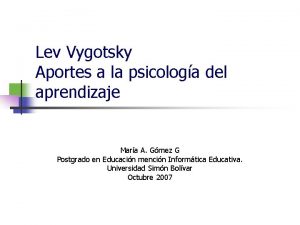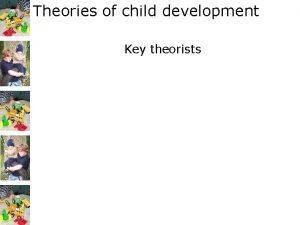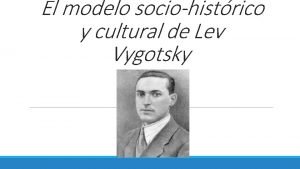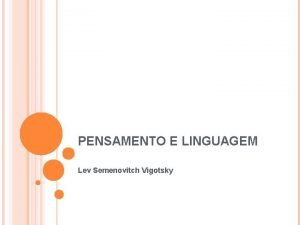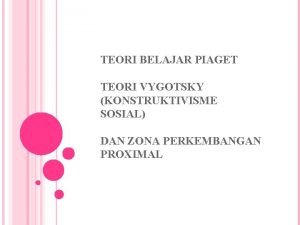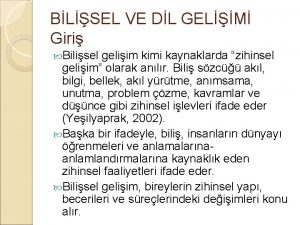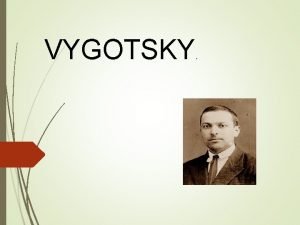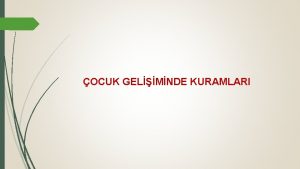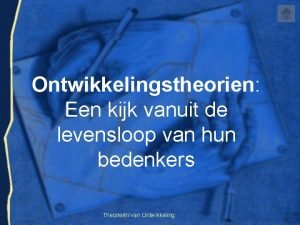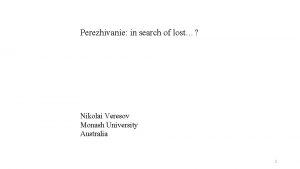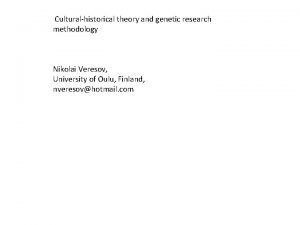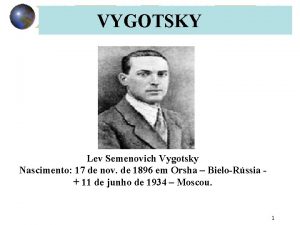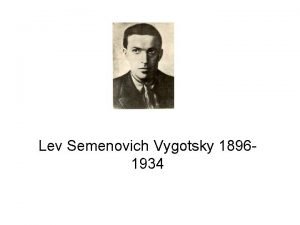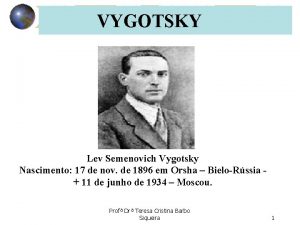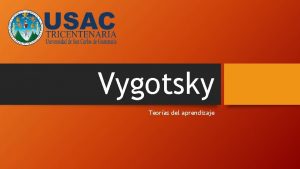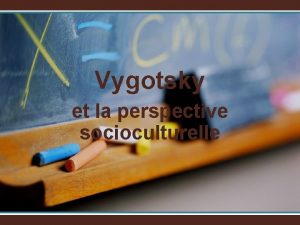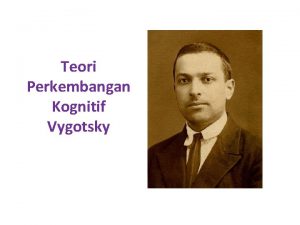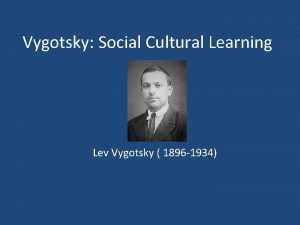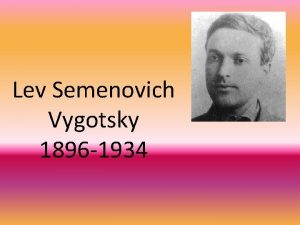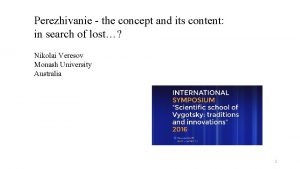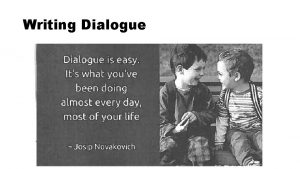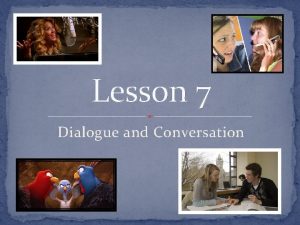Perezhivanie tantalizing concept Dialogue with Vygotsky Nikolai Veresov















































![[Psychology] … ought to always be capable of finding the particular prism through which [Psychology] … ought to always be capable of finding the particular prism through which](https://slidetodoc.com/presentation_image/242f650a41466ecdedf73ac9fc06ffcf/image-48.jpg)





- Slides: 53

Perezhivanie: tantalizing concept? Dialogue with Vygotsky Nikolai Veresov, Monash University, Australia

. . . perezhivanie thus far remains more a tantalizing notion than a concept with clear meaning and import to those who hope to draw on it. (Smagorinsky 2011, p. 339). 2

Antoniadou, V. (2011). Virtual collaboration, ‘perezhivanie’ and teacher learning: a socio-cultural-historical perspective. Bellaterra Journal of teaching & learning language & literature, 4(3), 53 -70 Brennan, M (2014). Perezhivanie: What Have We Missed about Infant Care? Contemporary Issues in Early Childhood, 15, 284 -292. Chen, F. (2015). Parents' perezhivanie supports children's development of emotion regulation: a holistic view. Early child development and care, 185, (6), 851 -867 Daniels, H. (2008). Vygotsky and research. Routledge. Daniels, H. (2010). Motives, emotion, and change. Cultural-historical psychology, 2, 24 -33. Fakhrutdinova L. (2010). On the Phenomenon of “Perezhivanie”. Journal of Russian and East European Psychology, 48 (2), 31 -47. Ferholt, B. (2009). The development of cognition, emotion, imagination and creativity as made visible through adult-child joint play: perezhivanie through playworlds (Doctoral dissertation). University of California, San Diego. Ferholt, B. (2010). A synthetic-analytic method for the study of perezhivanie: Vygotsky literary analysis applied to playworlds. In M. C. Connery, V. John-Steiner & Ana Marjanovic-Shane (Eds. ), Vygotsky and creativity: a culturalhistorical approach to play, meaning making, and the arts (pp. 163 -179). Peter Lang. Fleer, M. (2013). Theorising Play in the Early Years. Cambridge University Press Quiñones, G. & Fleer, M. (2011). "Visual Vivencias": A cultural-historical tool for understanding the lived experiences of young children's everyday lives". In E. Johansson & J. White (Eds. ), Educational research with our youngest: Voices of infants and toddlers. Netherlands: Springer. Mahn, H. (2003). Periods in child development. Vygotsky’s perspective. In A. Kozulin, B. Gindis, V. Ageyev & S. Miller (Eds. ), Vygotsky's educational theory in cultural context (pp. 119 -138). Cambridge. Mahn H, John-Steiner, V. (2002). The gift of confidence: A Vygotskian view of emotions. In G. Wells & G. Claxton (Eds. ). Learning for Life in the 21 st Century: Sociocultural Perspectives on the Future of Education (pp. 46 – 58). Blackwell. 3

2014 - ISCAR Sydney Congress: 5 presentations and 3 symposia on perezhivanie ISCAR Sydney Congress 2015 ISCAR Australia-Brazil international symposium on perezhivanie (Melbourne, Monash ISCAR Australia-Brazil University, February) 2016 International research in Early childhood journal (IRECE) – special issue on International research in Early childhood journal (IRECE) perezhivanie Mind, Culture and Activity journal (MCA) – special issue on perezhivanie Mind, Culture and Activity 2017 “Perezhivanie, emotions and subjectivity” – book, Springer Publishers “Perezhivanie, emotions and subjectivity” 4

“Perezhivanie is “probably one of the most used and least understood constructs to appear in contemporary literature” 5

Zone of proximal development is “probably one of the most used and least understood constructs to appear in contemporary educational literature” Palinscar, A. S. (1999). Keeping the metaphor of scaffolding fresh — A response to C. Addison Stone’s “The metaphor of scaffolding: Its utility for the field of learning disabilities”. Journal of Learning Disabilities, 31, p. 370 6

ARE WE STILL INTERESTED IN WHAT VYGOTSKY MEANS BY PEREZHIVANIE? What are methodological challenges? What are consequences to inform our research? 7

8

Perezhivanie (переживание) is a common name for direct psychological experience*. From a subjective perspective, every psychological process is perezhivanie. In every perezhivanie we distinguish: firstly, an act, and secondly, the content of perezhivanie. The first is an activity related to the appearance of certain perezhivanie; the second is the content, the composition of what is experienced (Varshava & Vygotsky 1931, p. 128). *Opyt (опыт) in the Russian original text. 9

What is perezhivanie? Psychological phenomenon (P. 1) P 1. 1. an activity connected to the emergence of the given perezhivanie (HOW? Process) P 1. 2. the content constituting what is being experienced (WHAT? Content) EXAMPLE: THINKING (PROCESS) – THOUGHT (CONTENT) 10

PEREZHIVANIE AS A CONCEPT IN CULTURALHISTORICAL THEORY - P 2. …perezhivanie is a concept which allows us to study the role and influence of environment on the psychological development of children in the analysis of the laws of development. Vygotsky, 1994, p. 343 11

Perezhivanie My dialogue with Vygotsky is about this Phenomenon (P 1) Concept (P 2) 12

WHAT IS THEORETICAL CONTENT OF THE CONCEPT OF PEREZHIVANIE (P 2)? TO FIND AN ANSWER WE HAVE TO IDENTIFY: • What aspect of human development this concept is related to? • How is this concept connected with other concepts within theory? 13

14

Perezhivanie in Vygotsky’s texts: - the prism - the unit of individual and environmental characteristics 15

Perezhivanie as a prism that refracts social influences …it is not any of the factors in themselves (if taken without reference to the child) which determines how they will influence the future course of his development, but the same factors refracted through the prism of the child's perezhivanie (Vygotsky, 1994, p. 339 -340). REFLECTION ----- REFRACTION 16

17

18

19

20

21

EDF 2030 22

Which of presented is about P 2? 23

…it is not any of the factors in themselves (if taken without reference to the child) which determines how they will influence the future course of his development, but the same factors refracted through the prism of the child's perezhivanie (Vygotsky, 1994, p. 339 -340). This is such a prism which determines the role and influence of the environment on the development on. . . the child's character, his psychological development, etc. (Vygotsky, 1994, p. 341) HOWEVER, WHAT DOES IT ACTUALLY MEAN? 24

1. Social environment as a source of development The social environment is the source for the appearance of all specific human properties of the personality gradually acquired by the child or the source of social development of the child (Vygotsky. 1998, p. 203). Development - how the social becomes the individual 25

SOCIAL SITUATION OF DEVELOPMENT: …completely original, exclusive single and unique relation specific to the given age, between the child and reality, mainly the social reality, that surrounds him. We call between the child and reality this relation the social situation of development at given age. The social situation of development represents the initial moment for all dynamic changes that occur in development. . . It determines wholly and completely the forms and the path along which the child will acquire ever newer personality characteristics, drawing them from the social reality as from the basic source of development, the path along which the social becomes the individual (Vygotsky, 1998, p. 198). 26

We are dealing with three children, brought to us from one family. The external situation in this family is the same for all three children. . . The mother drinks and, as a result, apparently suffers from several nervous and psychological disorders. The children find themselves in a very difficult situation. When drunk, and during these breakdowns, the mother had once attempted to throw one of the children out of the window and she regularly beat them or threw them to the floor. In a word, the children are living in conditions of dread and fear due to these circumstances (Vygotsky, 1994, p. 339 -340). The three children are brought to our clinic, but each one of them presents a completely different picture of disrupted development, caused by the same situation. The same circumstances result in an entirely different picture for the three children (Ibid). 27

The youngest of these children…. . . reacts to the situation by developing a number of neurotic symptoms, i. e. symptoms of a defensive nature. He is simply overwhelmed by the horror of what is happening to him. As a result, he develops attacks of terror, enuresis and he develops a stammer, sometimes being unable to speak at all as he loses his voice. In other words, the child's reaction amounts to a state of complete depression and helplessness in the face of this situation. (Ibid) 28

The second child approached the situation differently. He was . . . developing an extremely agonizing condition, a state of inner conflict. . . On the one hand, from the child's point of view, the mother is an object of painful intensive (NV) attachment, and on the other, she represents a source of all kinds of terrors and terrible emotional experiences [perezhivanija] terrible impressions for the child (NV). The second child was brought to us with this kind of deeply pronounced conflict and a sharply colliding internal contradiction expressed in a simultaneously positive and negative attitude towards the mother, a terrible attachment to her and an equally terrible hate for her a terrific attachment to her and an equally terrific hate for her (NV), combined with terribly contradictory behaviour. (Vygotsky, 1994, p. 340). 29

Finally, the third and eldest child . . . showed signs of some precocious maturity, seriousness and solicitude. He already understood the situation. He understood that their mother was ill and he pitied her. He could see that the younger children found themselves in danger when their mother was in one of her states of frenzy. And he had a special role. He must calm his mother down, make certain that she is prevented from harming the little ones and comfort them. Quite simply, he has become the senior member of the family, the only one whose duty it was to look after everyone else. As a result of this, the entire course of his development underwent a striking change. This was not a lively child with normal, lively, simple interests, appropriate to his age and exhibiting a lively level of activity. It was a child whose course of normal development was severely disrupted, a different type of child (Vygotsky, 1994, p. 340 -341). 30

So. . . depending on the fact that the same situation had been experienced by the three children in three different ways three different perezhivanie of the same situation appeared in three children (NV), the influence which this situation exerted on their development also turns out to be different (Ibid). 31

. . . by citing this example, I only wished to clarify the idea that. . . paedology does not investigate the environment as such without regard to the child, but instead looks at the role and influence of the environment on the course of development. …This is such a prism which determines the role and influence of the environment on the development of. . . the child's character, his psychological development, etc. (Ibid. ) 32

An example shows that while three children had the same social situation, they simultaneously had different social situations of development. To state a certain, general, formal position it would be correct to say that the environment determines the development of the child through experience perezhivanie (NV) of the environment; . . . the child is a part of the social situation, and the relation of the child to the environment and the environment to the child occurs through experience. . . perezhivanie (NV) of the child himself; the forces of the environment acquire a controlling significance because the child experiences them (Vygotsky, 1998, p. 294). 33

General genetic law of cultural development – fundamental! 34

"Every function in the child's cultural development appears twice: first, on the social level, and later, on the individual level; first, between people (interpsychological) and then inside the child (intrapsychological). All the higher functions originate as actual relationships between individuals. " (Vygotsky, 1978, p 57). “. . . every function in the cultural development of the child appears on the stage twice, in two planes, first, the social, then the psychological, first between people as an intermental category, then within the child as a intramental category. . . Genetically, social relations, real relations of people, stand behind all the higher mental functions and their relations…every higher mental function was external because it was social before it became an internal strictly mental function; it was formerly a social relation between two people (Vygotsky 1997, p. 106) 35

• Every higher mental function appears not IN social relations, but AS a social relation. • Social is not a factor, but as a source of mental development. • Category = drama! • The process of psychological development is a process of how inter-psychological becomes intra-psychological; • internalization is viewed as intra-lisation (from inter- to intra-), as a process of becoming intra-psychological as a unique combination of higher mental functions (psychological systems) of an individual within social contexts. • “an individual” is a unique unity of higher mental functions in motion, in its dialectical becoming. ISCAR SU 2016 36

THE CONCEPT OF DRAMA BACK TO THE DIALECTICS OF BECOMING Speaking on development we have to have in mind that the view of development in cultural-historical psychology originates in German philosophical tradition. Two aspects are important in this respect: (1) development is not possible without dialectical contradictions: contradiction is a moving force of development; (2) development is a process of qualitative reorganization of a certain system. To put it in a simple way – there is no development without dialectical contradictions and there is no development without qualitative reorganization of the system. ISCAR SU 2016 37

The basic principle of the functioning of higher functions (personality) is social, entailing interaction of functions, in place of interaction between people. They can be most fully developed in the form of drama… …the dynamic of the personality is drama” (Vygotsky, 1929/1989, p. 67). ” (Vygotsky, 1929/1989, p. 59 -61; Original emphasis) 38

Social environment is not a factor, it is a source of mental development • Development = how the social becomes and individual • Not transition from intra to inter, but the process of becoming • Through reorganisation of a system of mental functions • Dialectics of becoming = contradiction! Drama! 39

Drama of life = collision, contradiction DRAMATIC PEREZHIVANIE Qualitative change of the system of HMF Turning point of developmental trajectory 40

in the same social situation, three children had three different perezhivanie and therefore experienced three different dramas. This means that the initial intermental forms of their relations were essentially different in the same social situation. Consequently, because the initial intermental forms were different, the children’s social situations of development and their individual developmental trajectories became different. 41

Perezhivanie as a theortetical concept: P 2. 1. – the prism Social situation of development General genetic law of cultural development Development as drama P 2. 2. Perezhivanie as a unit 42

Complex whole (unity) = единство (edinstvo) Analysis by elements (элемент) Does not contain basic characteristics of a complex whole Analysis by units (единица) Contains basic characteristics of a complex whole 43

Unit Complex whole (unity) 44

Unit Complex whole (unity) 45

Vygotsky, 1998, Vol. 5, p. 294 Vygotsky, 1984, Vol. 4, p. 382 A unity can be noted in the study of personality and environment. This unity … has been called experience. The child's experience is also this kind of very simple unity about which we must not say that in itself it represents the influence of the environment on the child or the individuality of the child himself; experience is the unity of the personality and the environment as it is represented in development. A unit can be noted in the study of personality and environment. This unit …has been called perezhivanie. The child's perezhivanie is also this kind of very simple unit about which we must not say that in itself it represents the influence of the environment on the child or the individuality of the child himself; perezhivanie is the unit of the personality and the environment as it is represented in development. 46

Perezhivanie as a theortetical concept: P 2. 1. – the prism Social situation of development General genetic law of cultural development Development as drama P 2. 2. Perezhivanie as a unit of the unity of the environmental and personal aspects SOCIAL SITUATION OF DEVELOPMENT 47
![Psychology ought to always be capable of finding the particular prism through which [Psychology] … ought to always be capable of finding the particular prism through which](https://slidetodoc.com/presentation_image/242f650a41466ecdedf73ac9fc06ffcf/image-48.jpg)
[Psychology] … ought to always be capable of finding the particular prism through which the influence of the environment on the child is refracted, i. e. it ought to be able to find the relationship which exists between the child and its environment, the child's. . . perezhivanie, in other words how a child becomes aware of, interprets, and emotionally relates to a certain event. 48

What is perezhivanie? 49

Translation Original In modern theory, experience is introduced as a unity of consciousness, that is, a unity in which the basic properties of consciousness are given as such, while in attention and in thinking, the connection of consciousness is not given. In modern theory, perezhivanie is introduced as a unit of consciousness, that is, a unit in which the basic properties of consciousness are given as such, while in attention and in thinking, the connection of consciousness is not given. …experience is the actual dynamics of the unity of consciousness, that is, the whole which comprises consciousness Perezhivanie is a dynamic unit of consciousness, the consciousness consists of (складывается из) perezhivanie Vygotsky, 1998, p. 294 Vygotsky, 1984, p. 382 50

Perezhivanie as a theortetical concept: P 2. 1. – the prism Social situation of development General genetic law of cultural development Development as drama P 2. 2. Perezhivanie as a unit of the unity of the environmental and personal P 2. 3. - Perezhivanie as a unity dynamic unit of consciousness 51

Perezhivanie as a phenomenon (P 1) Phenomenological level of analysis Conceptual level of analysis Process Refracting prism Unit of individual and environmental Content Unit of consciousness 52

Academia. edu https: //monash. academia. edu/Nikolai. Veresov Google scholar https: //scholar. google. com. au/citations? user=Cr 0 Si 9 o. AA AAJ&hl=en https: //www. researchgate. net/profile/Nikolai_Veresov Research gate Personal site http: //www. nikveresov. net/417072700 Monash research profile http: //monash. edu/research/explore/en/persons/nikolay -veresov(62 b 49 fd 9 -59 a 7 -43 ae-8100 -e 2 f 001857866). html 53
 Nikolai veresov
Nikolai veresov Lhc tantalizing new physics
Lhc tantalizing new physics Perezhivanie meaning
Perezhivanie meaning Perezhivanie meaning
Perezhivanie meaning Lev vygotski asya vigodskaya
Lev vygotski asya vigodskaya Nikolai beev
Nikolai beev Nikolai franzewitsch gastello
Nikolai franzewitsch gastello Nikolai lipscomb
Nikolai lipscomb Nikolai yezhov
Nikolai yezhov Who is the author
Who is the author Nikolai lobachevsky
Nikolai lobachevsky Nikolai yezhov
Nikolai yezhov Nose
Nose N i pirogov
N i pirogov Expression of congratulations
Expression of congratulations Ideal self real self and actual self
Ideal self real self and actual self Perbedaan selling concept dan marketing concept
Perbedaan selling concept dan marketing concept Vygotsky ve piaget karşılaştırması
Vygotsky ve piaget karşılaştırması Piaget vygotsky karşılaştırma
Piaget vygotsky karşılaştırma Socioconstructivisme vygotsky
Socioconstructivisme vygotsky Piaget nature vs nurture
Piaget nature vs nurture Biografi lev vygotsky
Biografi lev vygotsky Teoria de lev vygotsky
Teoria de lev vygotsky Skinner piaget vygotsky
Skinner piaget vygotsky Piaget vs vygotsky
Piaget vs vygotsky Vygotsky theory of intelligence
Vygotsky theory of intelligence Psychosexual stages
Psychosexual stages Preoperational stage
Preoperational stage Vygotsky potansiyel gelişim alanı
Vygotsky potansiyel gelişim alanı Teori vygotsky
Teori vygotsky Bruner social constructivism
Bruner social constructivism Vygotsky zone of proximal development
Vygotsky zone of proximal development What is vygotsky's theory of scaffolding learning
What is vygotsky's theory of scaffolding learning Teori konstruktivisme sosial vygotsky
Teori konstruktivisme sosial vygotsky Cognitivism
Cognitivism Vygotsky's theory of cognitive development
Vygotsky's theory of cognitive development Lev vygotsky play theory
Lev vygotsky play theory Aprendizaje cooperativo segun vigotsky
Aprendizaje cooperativo segun vigotsky Playstpr
Playstpr Jerome bruner bilişsel gelişim kuramı
Jerome bruner bilişsel gelişim kuramı Internalization vygotsky
Internalization vygotsky Signos de vygotsky
Signos de vygotsky Lev vygotsky aportes
Lev vygotsky aportes Gessel theory
Gessel theory Zona de desarrollo proximo vygotsky
Zona de desarrollo proximo vygotsky Verbal significado
Verbal significado Vygotsky
Vygotsky Ostilah
Ostilah Piaget's stages of cognitive development
Piaget's stages of cognitive development Lineas de desarrollo vigotsky
Lineas de desarrollo vigotsky Yakınsak gelişim alanı
Yakınsak gelişim alanı Vygotsky schema
Vygotsky schema Tahap perkembangan kognitif menurut vygotsky
Tahap perkembangan kognitif menurut vygotsky Ontwikkelingstheorieën
Ontwikkelingstheorieën
